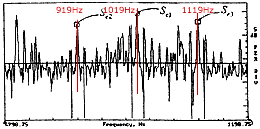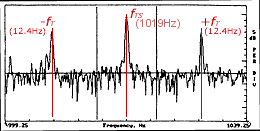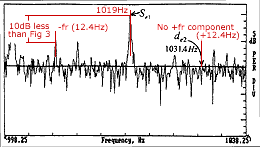Large HV, 3-Phase SCIM - Pump Drive
Background
and Test Objective
Four motor-pump drives were used to pump oil from an oil storage tank
farm into large tankers in a nearby deep water estuary.
One of the
motors had developed a bearing vibration and temperature problem and would
only run for 45 minutes since it tripped out on high bearing temperature
(95°C / 203°F).
The fundamental cause of the problem could not be determined via vibration
analysis.
MCSA was applied to determine the condition of the rotor winding and whether airgap eccentricity was the problem.

Figure
e-1
Current Spectrum - healthy rotor cage winding.
Nameplate
details
3-Phase, SCIM, 11 kV, 103 A,
1.45 MW/1944 h.p., 50 Hz, 742 r.p.m.
Additional
Information
8-pole, number of rotor slots = 62
Direct drive coupling
Full-load slip = 0.01 or 1%
Airgap length 2.54 mm (100 thou) ±5% (manufacturer's spec.)
±2sf
1
= 2 x 0.01 x 50 = ±1
HzThe motor was operating at slightly less than the full-load current : the input current was 91.3 A compared to the nominal full-load current of 103 A. This means that any sidebands due to broken rotor bars will be slightly less than ±1 Hz around f
1.
There are
sidebands at ±0.846 Hz around the supply frequency at 50
Hz but they are 60 dB down on f1
and are due to inherent rotor winding asymmetries, for instance in bar-to-end
ring joints.
|
frs
= f
1((R/p)(1-s)
± nws) ......... (E-1) |

Figure e-2
Current Spectrum to show rotor slot passing frequencies.
The frequency resolution is 1.0 Hz/line
|
fec
= f
1(((R
± nd)/p)(1-s) ± nws) ...... (E-2) |

Figure e-3
Current Spectrum indicitive of an airgap eccentricity problem.
The frequency resolution is 0.1Hz/line
Equation (E-1) is used to predict the rotor slot passing frequencies :
The number of rotor slots is required and as a first step the full-load slip can be used in equation (E-1)
With f1
= 50 Hz, R = 62, p = 4, s = 0.01, nws = 1, 3, 5
we get the following components all spaced 100 Hz (2
f1
apart) : 417.25 Hz, 517.25 Hz, 617.25 Hz, 717.25 Hz, 817.25 Hz, 917.25
Hz, 1017.25 Hz, 1117.25 Hz.
Examination
of Figure e-2 shows components spaced at 100 Hz apart (919, 1019, 1119
Hz) and they are very close to the above predicted values.
A more accurate spectrum analysis is now required to detect the components
given by equation (E-2) and the current signature pattern indicative of
abnormal airgap eccentricity:
Inserting
the same values and with nd = ±1, we get components
at ±12.367Hz (rotational speed frequency) around the rotor slot
passing frequency components.
Examination of Figure e-3 for the faulty motor shows there are components
at ±12.4 Hz around the rotor slot passing frequency of 1019 Hz,
likewise for the other rotor slot passing frequency components as shown
in Figure e-2.
The components at ±12.4 Hz correspond to the rotational speed of
the rotor, Nr = 60 x 12.4 = 744 r.p.m. and this is in line
with the fact the motor is on a slightly reduced load of 91.3 A compared
to the full load current of 103 A
(nominal full-load speed = 742 r.p.m.).
The operating slip is (750-744)/750 = 0.008.
Note the slip from the ±2s
f1
components in Figure e-1 = 0.00864 and this further validates the analysis.
The very
small difference in these two slips (6.4% using the full-load slip as
reference) from the spectrum analysis is that the analysis was done at
different times and any small change in speed is reflected in the result.
Note that the magnitudes of the -
fr and +
fr components are equal, and are only 15 dB down on
f1.
This
is indicative of an abnormal level of airgap eccentricity

Figure e-4
Current Spectrum - normal airgap eccentricity
Consider
one of the healthy motors:
Figure e-4 shows the current spectrum from a healthy motor with a normal
level of airgap eccentricity.
Comparison between Figures e-3 and e-4 clearly shows the signature patterns
are distinctly different.
There is no component at +fr above 1019 Hz in the healthy motor and the - fr component in the healthy motor is 10dB less compared to the faulty one.
EXPERT
COMMENT
Analysis
of the motor current spectra shown in Figure e-1 shows that there are
twice slip frequency sidebands due to inherent rotor asymmetry but they
are 60 dB down on
f1
- the rotor winding is healthy.
The current spectrum in Figure e-3 is indicative of abnormal airgap eccentricity
- as per the detailed analysis given above.
Airgaps to be firstly checked on site.
To read
the EXPERT RECOMMENDATION
- Click here
